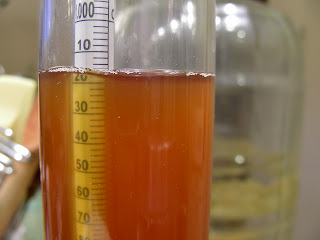Sunday, October 17, 2010
JDP2/FW1: I have a lot of beer
That's my fermentation room/basement beer closet. At present, it features five cases of beer: two cases of SR5, two cases of FW1 and one case of JDP2. It's fair to say that I'll be good for beer when all this homebrew is ready to drink come November.
On Friday, I bottled the FW1 cafe con leche stout and the JDP2 American scotch ale (which turned out to be more of a scottish ale due to the 6.4% A.B.V.). Now they'll need a few weeks in the bottle before they're ready. I'm hoping for a lot from the bottle conditioning.
Foreign Extra Stout and sure enough there was a sour component). Still, I want the flavor tamed a bit. The additional dry malt I added for bottle fermentation and a few more weeks of aging may help.
The other issue I had with the stout was poor attenuation. After nearly two weeks of fermentation, the stout went from an original gravity of 1.072 to a final gravity of 1.042. That's only 40% apparent attenuation. I was expecting around 70%. I don't mind that the A.B.V. is 4%, but I am disappointed in how poorly the yeast performed. I do wonder whether I should have let the stout ferment even longer, and what effect the lactose had, but all that is moot now that the beer is in the bottle.
On the bright side, I did get a distinct coffee/espresso flavor from the beer. So I'm hopeful that the beer will be drinkable next month.
In terms of flavor, JDP2 came out better. It's certainly not nearly as malty as JDP1, but I think I went to far the other direction. The beer was almost too dry, and I missed the brown sugar. In fact, you can see from the light color of the beer that it's not quite right. A scotch ale should be a dark amber. This is much more of a Scottish ale in color and alcohol content.
The reduced malt did allow the flavor of the rye to come through, so that's working well, but I'm didn't get much of the smoked malt. That may change after the beer finishes bottle conditioning. For the next batch, I think I add the brown sugar back in and maybe another pound or so of pale malt. I'm getting close, but I'm not quite there.
Subscribe to:
Post Comments (Atom)



No comments:
Post a Comment